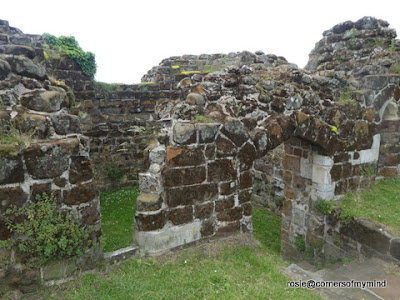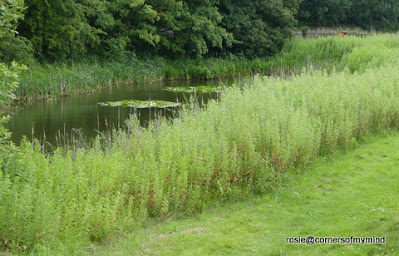It was a warm, sunny afternoon when we visited. The site was deserted so we had the place to ourselves. The castle seemed hard to find. We passed through Old Bolingbroke twice but then discovered we had missed a sign in the centre of the village and eventually, down a very narrow lane, we found the entrance by the lovely old cottage below.
The site is maintained by English Heritage.
The plan below shows the layout of the castle. Most of the information boards were faded and hard to photograph.
The plan is based on discoveries made during excavations carried out between 1965 and 1973. The great hall and kitchens have since been re-buried to protect them.
Above the view across the castle mound from the entrance we used.
The castle was built c. 1220 for Ranulf de Blundeville , Earl of Chester and Lincoln after his return from the Crusades. It was one of three castles built for him the others being Beeston Castle in Cheshire and Chartley in Staffordshire.
As I mentioned in my last post the castle was eventually inherited through his first marriage by John of Gaunt the third son of Edward III. He married Blanche, the daughter of Henry of Grosmont, the first Duke of Lancaster. Blanche and her sister Maud were born at Bolingbroke Castle.
Henry of Bolingbroke later King Henry IV, the son of John of Gaunt and his wife Blanche was born at the castle in 1367.
During the 15th and 16th centuries the castle was used as an administrative centre for the estates of the Duchy of Lancaster. Hence there being an Auditor's Tower and a Receiver's Tower.
The gatehouse towers by the main entrance to the castle. These towers contained rooms for the guards and storerooms below. These storerooms were later used as holding cells for prisoners awaiting trial at Bolingbroke Court house.
Again, as I also mentioned in my previous post, in the 17th century, during the Civil War, the castle was besieged and later destroyed by Parliamentarian troops. Below part of the castle moat.
When first built the castle was an enclosure castle, a typical 13th century castle, which had a courtyard within the curtain walls where there would have been timber framed structures including a Great Hall and service buildings as seen in the illustration below.
Below is a view from the Auditor's tower of the Rout Yard apparently there are several earthworks in the field and also the fishpond.














Such a shame that not much remains of the original castle. It looked so handsome from the illustration of it. I have never seen examples of castles with wooden structures built inside - it's fascinating! I hope you are feeling better Rosie. x
ReplyDeleteIt's easy to imagine the place buzzing with people working to serve the family that lived there, the timber great hall must have been quite impressive. I'm beginning to feel a little better Simone, thank you:)
DeleteThanks for such an interesting post and of course no structural buildings here in Oz before approximately 1800, so these old buildings you show,, blow me away. Take care & hugs.
ReplyDeleteGlad you enjoyed the post Susan, even though no longer functional these places are fascinating to visit. Take care:)
DeleteVery interesting Rosie. What a pity that such a significant place has gone but there is just enough left to conjure up what it might have been like in the past. It certainly is a beautiful spot. I loved that series of Shakespeare's historical plays the BBC did several years ago, your post has made me want to watch it all again. 😊
ReplyDeleteOh, yes I was thinking of Shakespeare's Wars of the Roses plays. I remember stopping up to watch them when I was a young teenager much to my Dad's annoyance as he couldn't complain as he thought they were educational. The later series a few years ago were good too. We saw many at Stratford over the years too. It was a lovely peaceful place just down the road from the air museum we visited on the same day:)
DeleteOh gosh Rosie what a super place - my son especially would love it there,. I know he keeps mentioning a visit to Beeston Castle but it is a long way for a day trip. English Heritage maintain so many fascinating places with such interesting history. The village looks picturesque too :)
ReplyDeleteI'm sure your son would be fascinated and you too but the church would call you as well, I wish we'd had time to visit as I found out later that it was open. We've been to Beeston a couple of times. Chartley isn't far away from here near Uttoxeter, it's a ruin on private land so you can't visit at all, it's just visible from the road.:)
DeleteLovely ruins.
ReplyDeleteThey are very visually pleasing:)
DeleteEnglish Heritage maintain some fascinating remains of buildings especially the castles. I wonder what happened to the items that were found during the excavations in the 1960s and 1970s? Perhaps they're in a museum in Lincolnshire or there are archived records? I'm glad you got back to Lincolnshire for your short break away and I hope that your health problem is improving with treatment.
ReplyDeleteThank you Linda, the last resilts from the CT scan were good so it's just a mattter of getting better little by little. It didn't say on the notice boards if there were any artifacts found during the excavations but I'm sure there would have been and no doubt they would be in Lincoln Musuem or a more local one. The earthworks discovered were reburied to preserve them. We used to be members of English Heritage but let it drift a while ago. They do look after some wonderful places:)
DeleteI'm glad the CT scan results were good. That's a relief. Old ruins are interesting especially if the information boards give plenty of detail. Archaeology is a fascinating field of study and the modern equipment to survey historical sites must create further projects. We don't travel around enough to be members of English Heritage or the National Trust but I enjoy one off visits when we do.
DeleteThank you Linda, it was a worry for a while as they thought I had a localised lung cancer but it was an infection which caused the blood clots. I worked in museums for over twenty years and came across quite a few archaeological collections, some out on display but many were still stored just as the archaeologists left them in paper bags, envelopes and tobacco tins. We are still members of the National trust but haven't used our cards very much over the last year or two:)
DeleteSomewhere I’ve not visited yet although I’ve read about a John of Gaunt and remember the Anya Seton book about him although I can’t recall the title! B x
ReplyDeleteOh, yes, Katherine by Anya Seton, I remember reading her historical novels many years ago along with those by Jean Plaidy and Margaret Irwin. It was about Katherine Swinford, John of Gaunt's mistress then third wife. Her sister married Geoffrey Chaucer. I saw Katherine's tomb in Lincoln Cathedral a few years ago.
DeleteAwesome photo's and history. So glad you found it and were able to tour around and explore.
ReplyDeleteSandy's Space
Thank you Sandy, it was a super placeto explore:)
Delete